Kuari Pass Trek
Kuari Pass Trek
₹ 8,500 /person | 6D - 5N | Rishikesh to Rishikesh
₹ 8,499/PP
6D - 5N |Rishikesh to Rishikesh
- Pickup Time : 7:30 To 8:00 AM
- Dropping Time : 7:30 To 8:00 PM
- Pickup & Drop Location : Haridwar Train Staion
- Inclusion & Exclusion
- Food provided by Indian Treks
Need Help Talk to our Mountain Expert
- +91- 7310954451 | +91-7300900108
BE UPDATED FOR THRILLING EXPERIENCES!
Follow Us On
➩ Description
- Altitude : 4264mtr
- Duration: 6 Days
- Trek Length: 32km
- Base Camp: Joshimath
- Trek Difficulty : Easy to Mod.
During the time when the British governed India, the Kuari Pass Trek was investigated by Lord Curzon. At an elevation of 4,264 metres, it is the ideal trek for novice hikers and can be found in the Garhwal region of the Himalayas. If you are a novice hiker and are considering beginning your mountaineering career in the Himalayas, then Kuari Pass is an excellent choice for the first walk of your Himalayan expedition. 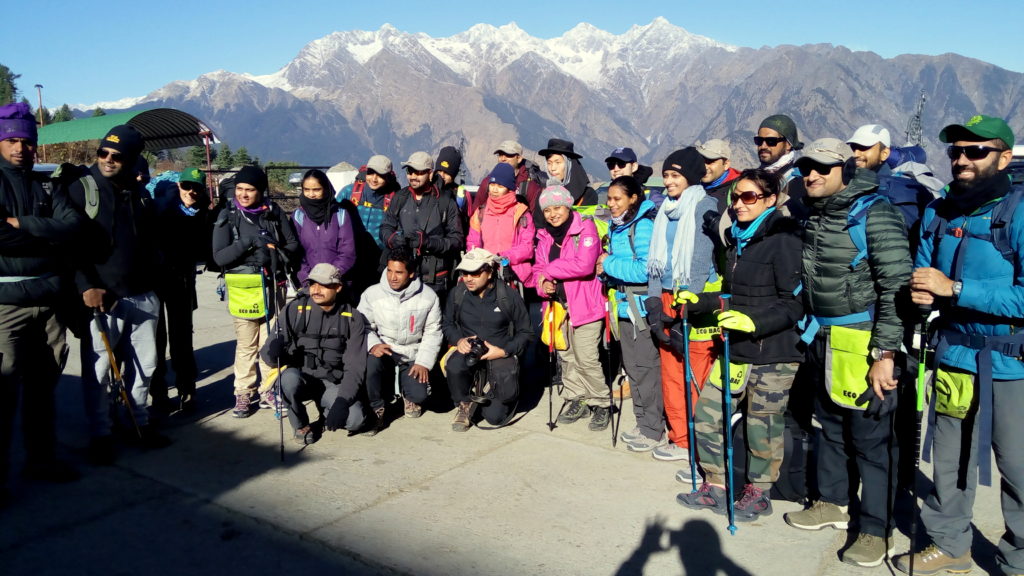 In addition to this, it is ideal for those who like environment due to its unspoiled surroundings, picturesque landscapes, and views of towering peaks. It doesn’t matter whether you go in the winter or summer; the Kuari Pass Climb is a stunningly beautiful uphill journey in the Uttarakhand Himalayas.
In addition to this, it is ideal for those who like environment due to its unspoiled surroundings, picturesque landscapes, and views of towering peaks. It doesn’t matter whether you go in the winter or summer; the Kuari Pass Climb is a stunningly beautiful uphill journey in the Uttarakhand Himalayas.
Read More
This trek is ideal for those who have a strong love for mountaineering and see it as having a significant role to play in their lives. In spite of the fact that the peak is at a relatively low height, we advise having a high level of physical endurance and a proven track record of fitness. To go from Dehradun to Joshimath and back to Dehradun again, you will need to take a cab for a total of 544 kilometres, and then you will need to walk 33 kilometres from Dhak Village to the kuari pass peak 12516 feet and then back to Joshimath. These hikes are not too challenging, but they are doable. We’ve been leading them for the last 30 years, and during that time we’ve met individuals from all over the globe who have varying degrees of fitness, but everyone has been able to complete the Kuari pass hike. Major Attractions of the Kuari Pass Trek Talli Forest: Next, you enter the Talli Forest, a magical place that feels like wandering into a snowy kingdom. Tall pine and oak trees surround you, their trunks dusted with snow. Sometimes, sunlight filters through the thick canopy, casting patterns on the ground. The quiet here is deep, disturbed only by your footsteps and the occasional chirp of a hidden bird. It’s a spot that invites you to pause, take a deep breath, and enjoy the peace of the wilderness. Kuari Pass: You will climb higher, where the trail opens to Kuari Pass, a viewpoint that feels like the roof of the world. From here, the vast Himalayas stretch out in all directions, with the peaks rising majestically. It’s a perfect place to rest and admire the beauty around you—a view that makes each step of the climb worthwhile. Gorson Bugyal: On your return, you pass through Gorson Bugyal, an alpine meadow. Indiantreks includes this route to let trekkers experience its beauty. In winter, this vast area is blanketed in snow, sparkling under the sun. The meadow provides a stunning contrast to the dense forests below. From here, you will see the best views of Nanda Devi Peak. Standing there, surrounded by snow and sky, you can’t help but feel deeply relaxed. Witness the Mighty Nanda Devi Peak Winter Kuari Pass – Lord Curzon’s Trail His support and exploration of this pass greatly boosted its popularity, leading to the trek being named in his honor. This connection to Curzon adds a historical appeal to the Kuari Pass trek, linking it to British exploration in India. Why is Kuari Pass Considered the Best Winter Trek in India? 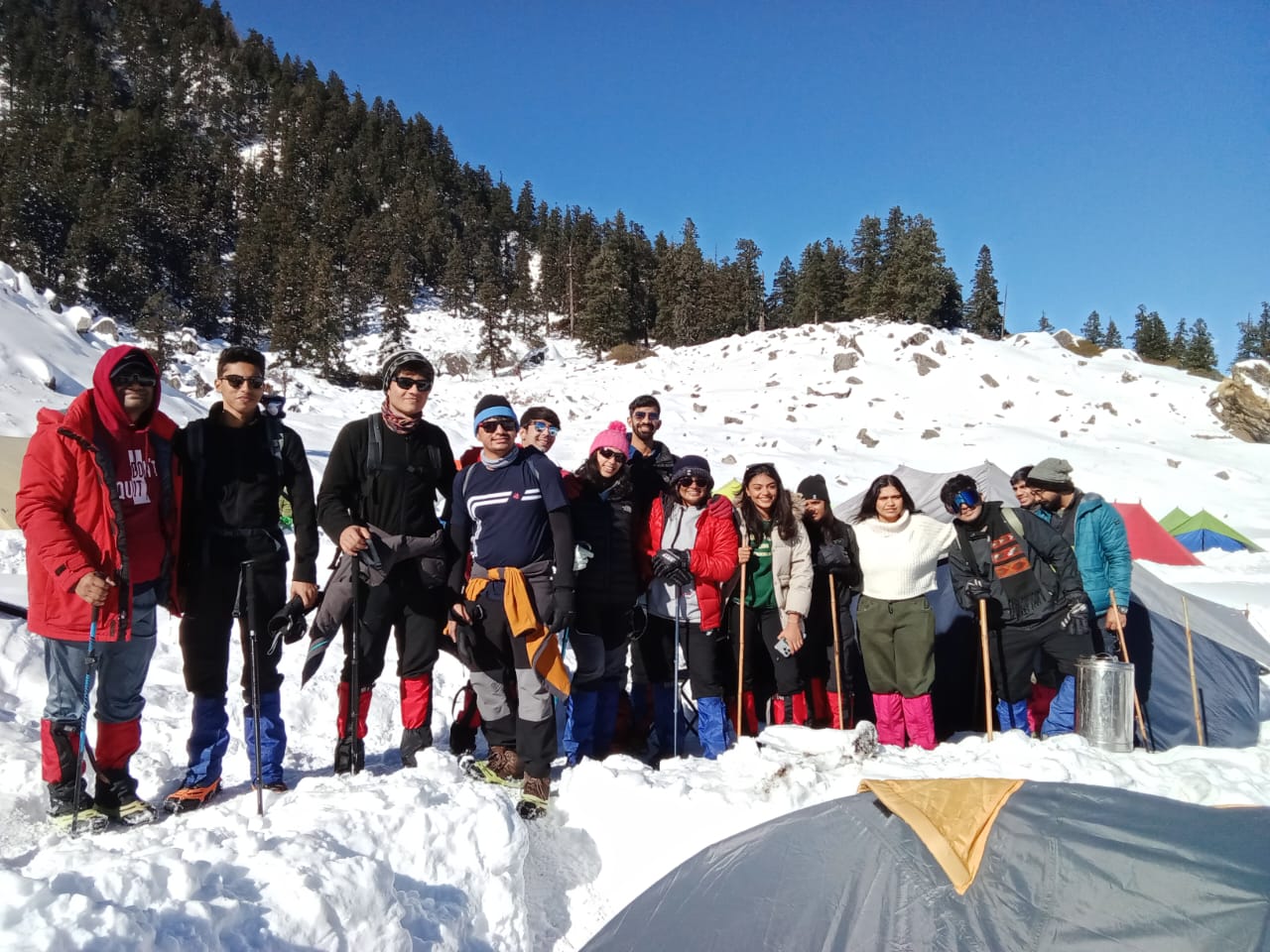 Don’t give too much thought to it; instead, focus on the natural world around you, and everything will come easily to you. However, you should always seek the assistance of your trek leader, get up early while on the journey, and practise yoga and pranayam each morning.
Don’t give too much thought to it; instead, focus on the natural world around you, and everything will come easily to you. However, you should always seek the assistance of your trek leader, get up early while on the journey, and practise yoga and pranayam each morning.
Tugasi: The trek starts in Tugasi, where the adventure truly begins. As you begin your climb, the trail winds gently through ancient oaks with branches heavy with snow. You’ll first see the snow-covered paths ahead, along with wide mountain views peeking through the trees. The soft crunch of snow under your boots sets the tone for the days ahead.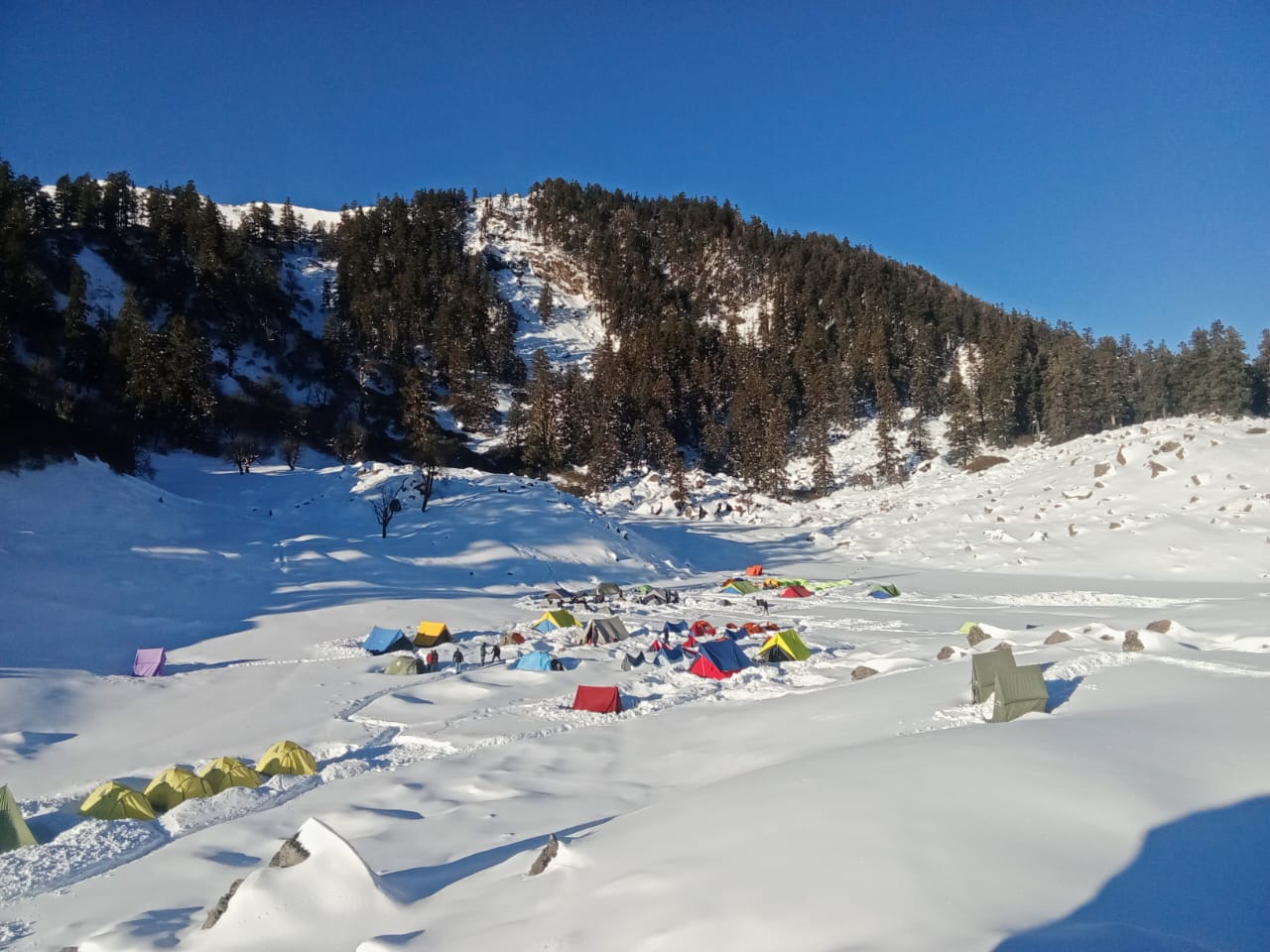
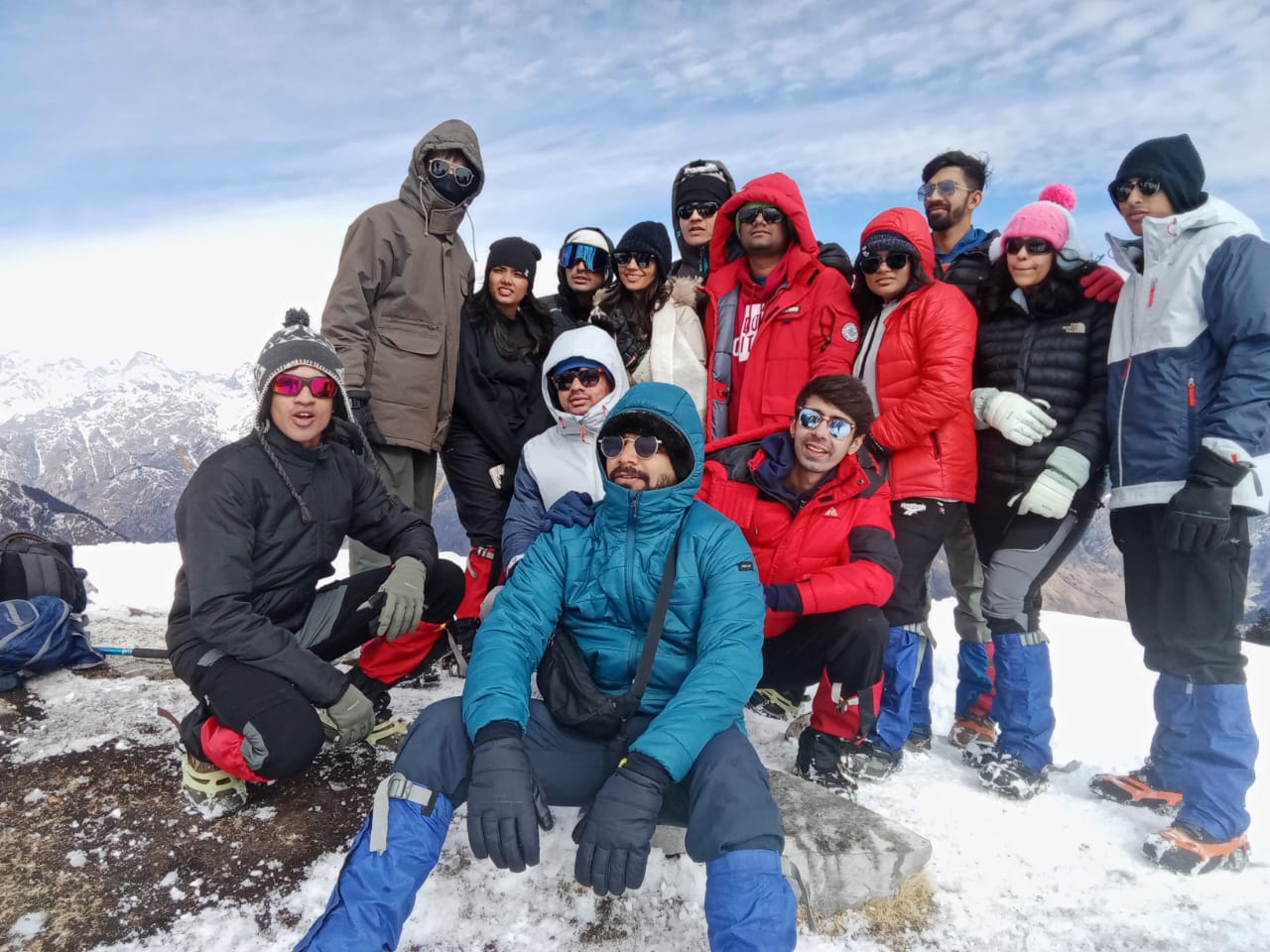
The main attraction of the Kuari Pass Trek is the opportunity to see Nanda Devi, the highest peak in Uttarakhand. You’ll also spot other famous peaks like Dronagiri, Chaukhamba, and Hathi Parbat. Seeing Nanda Devi up close is an unforgettable experience.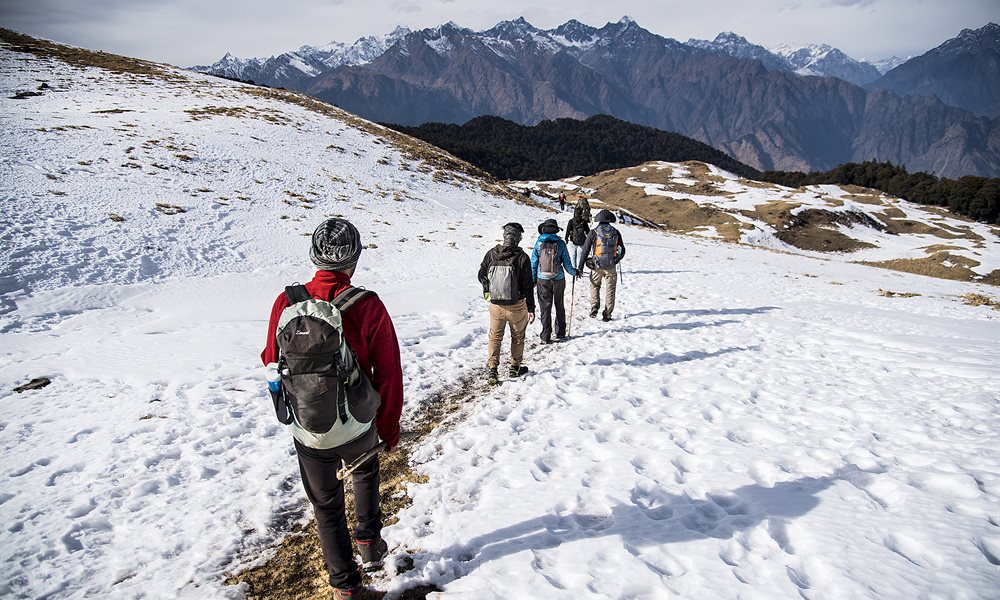
The Kuari Pass Trek is known as the “Curzon Trail” because Lord Curzon, the Viceroy of India from 1899 to 1905, popularized it. An enthusiastic trekker and explorer, Lord Curzon traveled extensively in the Himalayas. During his time in office, he trekked through Kuari Pass and was so taken by its beauty that he recommended it as an important trekking route.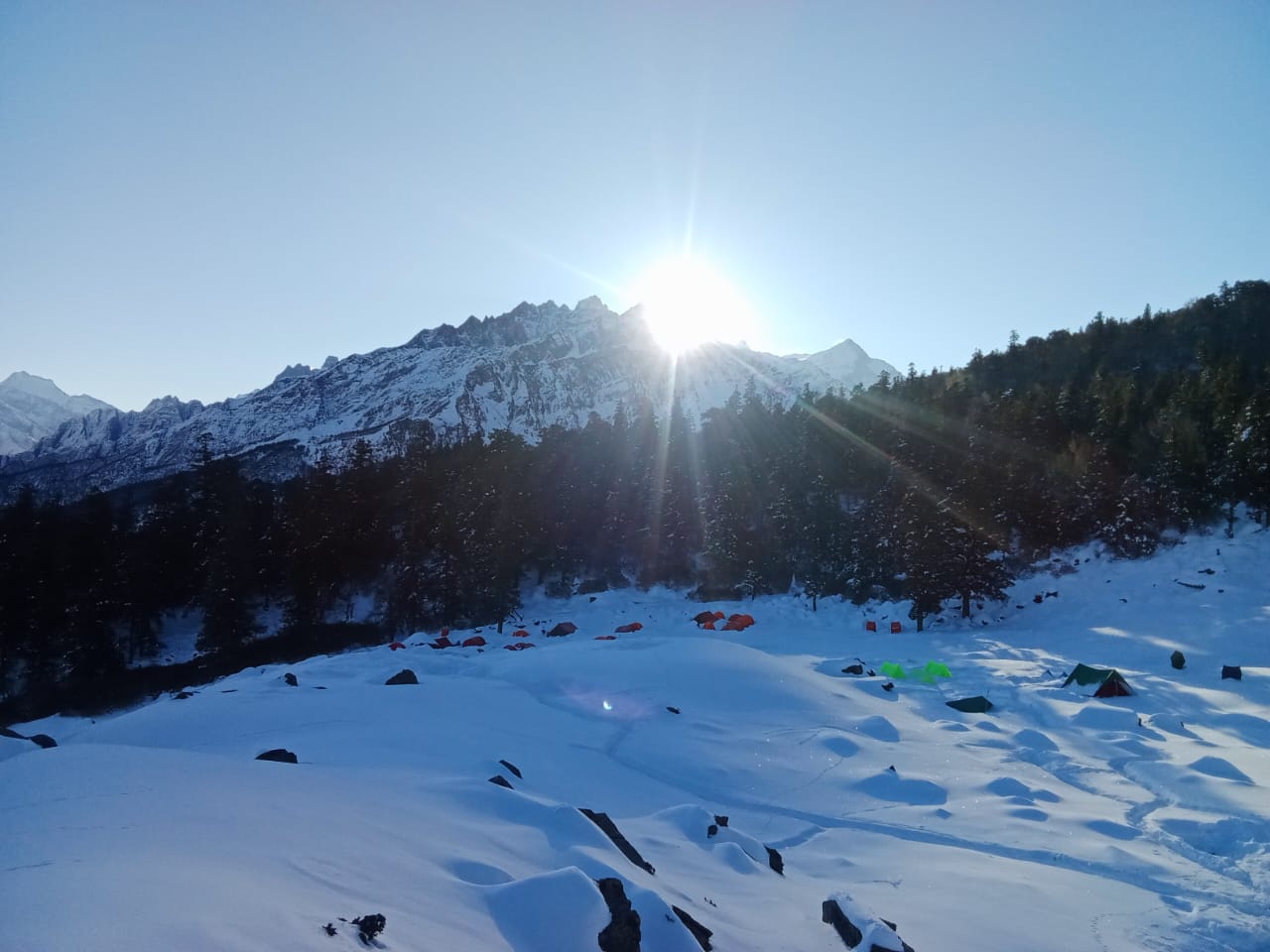
Winter offers a quieter time compared to the busy trekking months, making the Kuari Pass trek one of India’s top winter adventures. The trail is less crowded this season. Trekkers can enjoy a more peaceful experience, away from the usual crowds. As winter arrives, fresh snow blankets the landscape, turning the trail into a beautiful white wonderland. You will walk through snow-covered forests, with breathtaking views of the Himalayan peaks at every turn. The trek’s moderate difficulty makes it accessible, yet it still provides the excitement of a high-altitude adventure. Whether you find joy in walking on fresh snow, camping under a starry sky, or taking in panoramic views of peaks like Nanda Devi and Dronagiri, Kuari Pass offers an unforgettable winter experience. That’s why it is often called the “Best Winter Trek in India.”
➩ Itinerary
Altitude Gain: 2,089 ft to 8,530 ft | Drive Distance: 280 km | Drive Duration: 9 to 10 hours | Overnight Stay: Joshimath Hotel Dhaneesh (Twin Sharing) | Pick-up point for Indiantreks trekkers: Tapovan badrinath road & Railway Station
Trekkers will be picked up from Rishikesh at 6:30 AM in a Bolero or similar vehicle (cost included in the package). Along the way, you can stop for breakfast and lunch at local dhabas or restaurants (meals not included).
The drive from Rishikesh to Joshimath is long but incredibly scenic. As the road winds along the Alaknanda River and through the Garhwal Himalayas, you’ll pass charming mountain towns, lush valleys, and breathtaking views that set the perfect tone for the adventure ahead.
Journey from Rishikesh to Joshimath
Your adventure begins from Rishikesh, the official starting point of the trek. The pickup will be arranged in Rishikesh, and from there we follow the scenic Badrinath Highway towards Joshimath.
Rishikesh itself is a destination worth exploring. If time allows, you can plan a short stay here before or after the trek to enjoy its spiritual charm, yoga culture, river rafting, and Ganga Aarti at the ghats.
The drive to Joshimath (2,050m / 6,750 ft) takes nearly 10 hours and covers around 256 km. Though long, the road is filled with spectacular views. The Alaknanda River accompanies you almost throughout the journey, turning more ferocious as you ascend higher into the Himalayas.
One of the highlights of this road trip is crossing the Panch Prayag—the five sacred confluences where tributaries join the Ganga:
Devprayag – where Bhagirathi meets Alaknanda
Rudraprayag – where Mandakini merges with Alaknanda
Karnaprayag – where Pindar joins Alaknanda
Nandaprayag – where Nandakini flows into Alaknanda
Vishnuprayag – where Dhauliganga meets Alaknanda
Each Prayag is not only spiritually significant but also breathtakingly scenic. Keep your camera ready, stay awake, and soak in every moment of this unforgettable drive into the mountains.
Altitude Gain: 7,545 ft to 8,530 ft to 9,264 ft | Trek Distance: 3 km | Trek Duration: 3 to 4 hours | Trek Difficulty: Easy to Moderate | Overnight Stay: Gulling Campsite (Twin Sharing)
A series of ice-capped mountains greets us in Joshimath, looking even more inviting than they did at the dawn of our journey. After an early breakfast, we set off for Dhak Village, about 12 km away in the Joshimath Tehsil—a drive of roughly 45 minutes. This is where our trek begins.
From Dhak, the trail steadily ascends, leaving behind the road and climbing towards Tugasi village. The dirt path includes a few sharp T-turns before easing out on flatter ground, followed by gentle rising slopes. The terrain here is generally rugged, with terraced fields and rocky outcrops. Though greenery is sparse, the panoramic views of the Garhwal Himalayas unfold dramatically in all directions.
Keep an eye out for the shimmering Dhauli Ganga River flowing deep below, as well as the massive Vishnugad Tapovan Hydroelectric Power Station along the valley. Unlike higher altitudes, you won’t find snow here, but the landscapes are equally captivating.
After about 20–25 minutes of trekking, we reach Kharchi village, where trekkers can refill bottles and take a short break. The trail then continues with steep switchbacks until Lower Tugasi, before splitting in two. We follow the route alongside a traditional hydro-powered flour mill, leading us into Upper Tugasi, a charming hamlet dotted with wheat fields, flower patches, thatched-roof houses, and mountain streams.
From here, the trail climbs gradually, leaving farmland behind, and soon reveals the first stunning view of Mount Dronagiri (7,066m) rising sharply in the distance. The sight is breathtaking and sets the tone for the trek ahead.
By afternoon, we reach Gulling Top Campsite (2,900m), nestled in open meadows surrounded by oak and rhododendron forests. After settling in, enjoy a hot lunch at the campsite. The evening is free to relax, soak in the mountain serenity, and admire the snow-covered slopes around. Adventurous trekkers may even join the trek leader for a short hike up to the Gulling Top viewpoint for closer glimpses of the icy forests.
As dusk falls, prepare for a magical night under the stars. The highlight awaits at dawn—when the first rays of sunlight strike Dronagiri peak, painting it in hues of gold and crimson, right from your campsite.
Overnight stay in tents on a twin-sharing basis at Gulling Top.
Altitude Gain: 9,264 ft to 11,014 ft | Trek Distance: 5.5 km | Trek Duration: 8 to 9 hours | Trek Difficulty: Easy to Moderate | Overnight Stay: Khullara Campsite (Twin Sharing)
Today’s trail takes you deeper into the wilderness, with a steady ascent from Gulling Top to Talli Forest Camp (3,350m). Compared to the steep climb of the previous day, the slopes are gentler and the walk more pleasant, offering a welcome change of pace.
The trail winds through enchanting forests of rhododendron, oak, and walnut. In late March, the rhododendrons bloom in brilliant shades of pink and white, adding a magical charm to the trek. The dense forest canopy, the earthy fragrance of leaves, and the quiet rustling of the woods create an almost mystical atmosphere.
About 20 minutes into the hike, the trees part to reveal a wide green meadow overlooking the majestic snow-covered ranges. This is a perfect spot to rest, click photos, and soak in the grandeur of the Himalayas before continuing. From here, a small stream crossing leads you back into a mixed forest of rhododendrons and conifers, gradually thickening as you gain altitude.
In winter, this entire stretch transforms into a snow wonderland, with thick blankets of snow draped over oak and conifer trees, turning the trail into a dreamy white corridor.
By afternoon, you’ll reach Talli Forest Camp, set amidst dense woods with views that open up towards the iconic Hathi–Ghoda peaks and the ever-dominant Dronagiri standing proudly to your right.
Enjoy a hot lunch at the campsite and spend the evening in the serene lap of nature. This forest clearing is a magical place for stargazing at night, with the silhouettes of snowy peaks in the backdrop.
Overnight stay in tents on a twin-sharing basis at Talli.
Altitude Gain & Loss: 11,014 ft to 12,516 ft to 11,014 ft | Trek Distance: 8 km | Trek Duration: 8 to 9 hours | Trek Difficulty: Moderate | Overnight Stay: Khullara Campsite (Twin Sharing)
Today is the most awaited day of the Kuari Pass Trek—the summit climb. We start early from the Khullara campsite, located at the base of Kuari Pass, to make the most of clear skies and the crisp morning views.
Khullara to Kuari Pass Summit
The trail begins with a gradual but steady climb through alpine meadows, rocky sections, and occasional snow patches (depending on the season). As you gain altitude, every step rewards you with expanding Himalayan vistas.
Reaching Kuari Pass (4,264m) is a truly breathtaking moment. From here, a 360° panorama of the Garhwal Himalayas unfolds before your eyes—dominated by towering snow-capped giants like:
Nanda Devi (7,816m) – the highest peak entirely in India, revered as the “Goddess of Bliss.”
Kamet (7,756m) – the second-highest peak in Garhwal, with its striking pyramid shape.
Dronagiri (7,066m) – steeped in mythology and known for its sheer beauty.
Chaukhamba (7,138m) – a magnificent massif of four peaks, often called the “Four Pillars.”
Hathi Parvat (6,727m) – resembling an elephant, standing tall in grandeur.
Ghori Parbat (6,708m) – another mighty peak, adding to the spellbinding skyline.
The view from Kuari Pass is considered one of the finest Himalayan panoramas in India. Spend some time here soaking in the sight, capturing photographs, and experiencing the stillness of the high mountains.
Return to Khullara
After enjoying the summit, retrace your steps back down towards Khullara campsite. The descent is easier and gives you a chance to once again admire the rolling meadows, alpine ridges, and forested valleys.
Before returning to camp, stop at the Khullara Viewpoint, which offers another stunning perspective of the mountains and valleys, especially during sunset when the peaks glow in warm hues.
Evening will be spent resting at camp, reflecting on the unforgettable summit experience.
Overnight stay in tents at Khullara (twin sharing).
Altitude Loss: 11,014 ft to 8,530 ft to 7,545 ft | Trek Distance: 8.5 km | Trek Duration: 6 to 7 hours | Drive Distance: 15 km | Drive Duration: 30 minutes to 1 hour | Overnight Stay: Hotel stay in Joshimath-(Twin/Triple sharing)
After breakfast, we begin our final descent from Khullara campsite towards Tugasi Village. The trail is mostly downhill, winding through alpine meadows, terraced fields, and oak–rhododendron forests. Though it’s easier than the ascent, the long descent of 8.5 km can still be demanding on the knees, so trekking poles are helpful.
On the way, enjoy the last glimpses of the Garhwal Himalayas—with views of Dronagiri, Hathi–Ghoda, and the surrounding ridges gradually fading into the distance as you descend lower into the valley. After about 6–7 hours of trekking, you will reach Tugasi Village, the endpoint of your trek.
Here, vehicles will be waiting to drive you back to Joshimath (15 km, ~30–45 min). The drive is short but scenic, offering yet another chance to admire the river valleys, forested slopes, and distant snowy peaks. If time permits, you can stop at viewpoints along the way for quick photographs.
By evening, you’ll be settled in Joshimath, marking the end of your Kuari Pass trekking adventure.
Overnight stay in guesthouse/hotel at Joshimath.
Altitude Loss: 8,530 ft to 2,089 ft | Drive Distance: 280 km | Drive Duration: 9 to 10 hours | Drop-off point for Indiantreks trekkers: Tapovan badrinath road & Railway Station
Route: Joshimath → Nandaprayag → Karnaprayag → Rudraprayag → Srinagar (Garhwal) → Devprayag → Rishikesh → Dehradun
Wake up to your last breakfast with Indiantreks at Joshimath. After an early meal, we depart by 6:00 AM for the return journey. Lunch will be taken en route, and you are expected to reach Rishikesh/Dehradun by evening (around 6–7 PM).
The drive from Joshimath to Rishikesh is long but spectacular. The road meanders along the Alaknanda River, passing through quaint Himalayan towns such as Chamoli and Devprayag, where the Bhagirathi and Alaknanda merge to form the holy Ganga. The winding mountain roads offer countless views of deep valleys, rushing rivers, and terraced villages.
To make the journey comfortable, we take short halts at roadside dhabas for refreshments. Starting early helps avoid traffic congestion and ensures a smooth ride back.
By evening, you’ll arrive in Rishikesh/Dehradun, carrying home unforgettable memories of the Kuari Pass Trek.
➩ Trek Cost Inclusions
Transportation
Pick-up and drop from Dehradun/Rishikesh to Joshimath (Tempo Traveller – Non AC).
Permits & Entry
Forest permits and all mandatory entrance fees.
Accommodation
Hotel stay in Joshimath.
Comfortable tented accommodation on twin/triple sharing basis during the trek.
Read More
Meals
All vegetarian meals during the trek:
Breakfast, Lunch, Evening Snacks, Soup, Tea/Coffee, and Dinner.
Camping Equipment
High-quality dome tents.
Sleeping bags with liners.
Insulated mattresses.
Toilets & Dining
Separate toilet tents for men and women.
Spacious dining tent with dining table and camping chairs.
Support Team
Qualified Trek Leader & Technical Guide.
Kitchen staff and trek support team.
Safety Equipment
Well-stocked medical kit.
Oxygen cylinders for emergencies.
Radio walkie-talkies for team communication.
Trek Gear Provided
Crampons.
Gaiters.
Certification
Official Trek Completion Certificate from Indiantreks.
➩Trek Cost Exclusions
Any meals or accommodation beyond the itinerary or not mentioned in the program.
Bus fare / Airfare to and from trek start or end point.
Personal medical expenses (participants are advised to carry personal medication).
Personal services such as laundry, phone calls, liquor, bottled/mineral water, etc.
Still / video camera fees at monuments, monasteries, museums, or temples (payable directly on the spot).
Backpack offloading (Mule/Porter charges):
Pre-booking (online in advance): ₹1,680 per bag for the entire trek.
On-spot payment: Charges may increase by up to 30%.
Weight Limit: Maximum 10 kg per bag.
Note: Backpack offloading is optional and recommended for those preferring to trek with a lighter daypack.
Emergency evacuation charges, if any.
Any services not specifically mentioned under Cost Inclusions.
➩ Complete Fitness Preparation Guide for Kuari Pass Trek
Trekking in the Himalayas, especially on a trail like Kuari Pass (12,516 ft), requires both breathtaking views and endurance. Fitness training is essential for fully enjoying the walk while avoid unnecessary strain or injury. This does not imply that you must be an athlete; nonetheless, developing strength, stamina, and flexibility before to the trek will make the journey safer, more comfortable, and enjoyable.
Read More
Here’s a detailed guide to help you prepare step by step. 1. Lower Body Strength: The Powerhouse a. Squats How to do it: b. Lunges How to do it: 2. Upper Body Strength: Backpack Support a. Push-Ups How to do it: b. Pull-Ups / Bodyweight Rows How to do it: 3. Core Strength: Stability Engine a. Planks How to do it: b. Russian Twists How to do it: 4. Full Body & Cardiovascular Endurance a. Burpees How to do it: b. Mountain Climbers How to do it: 5. Cardio Conditioning: The Foundation 6. Stretching & Recovery Final Words Ideally, start preparing 4–6 weeks before your trek. This lowers the chance of injury, increases endurance, and allows your body to gradually adjust. Each climb will seem less intimidating, your backpack won’t feel heavy, and you’ll feel lighter on your feet once you’re on the trail. think of this preparation as an investment: every squat, lunge, or plank you do today translates into more energy for soaking in Himalayan views tomorrow. Instead of gasping for breath or battling sore legs, you’ll be free to enjoy the snow peaks, the alpine meadows, and the magical forests Kuari Pass is famous for. In the end, the trek isn’t just about reaching the pass—it’s about enjoying every step of the journey. With the right preparation, you won’t just complete Kuari Pass, you’ll cherish it.
When trekking, most of the effort comes from your legs. Whether it’s a steep ascent, a rocky descent, or long hours on uneven trails, lower body strength decides your performance.
Targets: Quadriceps, hamstrings, glutes, calves
Why important for trekking:
Quads & glutes power uphill climbs
Hamstrings & calves provide balance for descents
Supports knee stability on uneven terrain
Stand with feet shoulder-width apart, toes slightly outward.
Bend knees and hips, keeping back straight.
Lower until thighs are parallel to the ground.
Push through heels to return to standing
Targets: Quads, hamstrings, glutes, calves
Why important:
Improves balance and stability on rocky slopes
Builds unilateral (single-leg) strength, crucial for stepping on uneven ground
Increases flexibility, reducing risk of muscle strain
Stand upright, feet hip-width apart.
Step forward with one leg, lowering both knees at 90°.
Push back through the front heel to return.
Alternate legs.
Many trekkers ignore the upper body, but carrying a 10–12 kg backpack for hours requires strong shoulders, arms, and back muscles. A weak upper body leads to poor posture, backaches, and quick fatigue.
Targets: Chest, shoulders, triceps, core
Trekking benefit:
Strengthens shoulders and chest to support backpack weight
Helps maintain upright posture during long hours
Start in plank position, hands under shoulders.
Lower chest close to ground, elbows bent.
Push back to plank position.
Targets: Back, shoulders, biceps
Trekking benefit:
Prevents back strain from constant backpack load
Improves posture and balance
Grip a bar overhead, palms facing forward.
Pull yourself up until chin clears bar.
Slowly lower down
Your core (abs, obliques, lower back) acts as a stabilizer. A strong core keeps you balanced on narrow ridges, slippery slopes, and rocky trails.
Targets: Abdominals, obliques, lower back
Trekking benefit:
Improves stability and posture
Prevents back fatigue on long treks
Elbows under shoulders, body in straight line.
Engage core, don’t sag hips or arch back.
Hold for 30–60 seconds.
Targets: Obliques, core
Trekking benefit:
Builds rotational strength for balance on uneven paths
Sit with knees bent, lean back slightly.
Hold hands together or a weight.
Twist torso side-to-side, touching ground beside hips.
Cardio fitness ensures you can trek for 6–7 hours daily without exhaustion. Combining cardio with strength makes you trek-ready.
Targets: Legs, chest, arms, core
Trekking benefit:
Boosts heart rate and overall stamina
Trains agility and coordination
From standing → squat → plank → push-up → jump up.
Repeat quickly.
Targets: Core, shoulders, chest, legs
Trekking benefit:
Builds speed, agility, and endurance
Start in plank position.
Alternate driving knees toward chest quickly, like running
Strength is essential, but without stamina, treks become exhausting.
Jogging or brisk walking – 20–30 mins daily
Stair climbing with backpack – 10–15 mins
Cycling or swimming – 2–3 times a week
Practice hikes on weekends with a loaded backpack
Flexibility prevents injuries and speeds recovery. Always:
Warm up before workouts (5–10 min light cardio)
Stretch hamstrings, calves, shoulders, hips after workouts
Include yoga poses like downward dog, warrior stretch
Take at least 1 rest day per week for recovery
Preparing for the Kuari Pass Trek isn’t about lifting heavy weights or spending hours at the gym—it’s about building the right kind of strength, endurance, and mental readiness. Simple routines like jogging, bodyweight exercises, and daily stretching go a long way in training your muscles for climbs, descents, and long hours of walking.
➩ Safety
Points to remember for safety in the trek:
- It is essential that you arrive at the starting point of any hike or excursion in the best possible physical condition and readiness.
- The hike is not tough; in fact, if you can keep both your feet and your mind calm and strong during the journey, you will discover that the hike is rather simple.
Read More
➩ How to Reach
Directions to go to Haridwar:
- By Air: Jolly Grant Airport is the domestic airport that serves Dehradun (which is near to Haridwar), and it receives frequent flights from the main metropolises located across India.
- Traveling by Train: The Haridwar junction is the closest railway station, and it has excellent connections to major cities located around India.
- By Road: The road network in and around Haridwar is extensive and convenient. To get to Haridwar from Delhi or any of the other surrounding cities, you have the option of either driving there yourself or hiring a cab or taxi. In addition, there is a consistent bus service between Haridwar and the surrounding areas because to the extensive road network.
➩ FAQ's
Trekking in Kuari Pass is said to be most enjoyable between the months of March to Mid-June and September to November. These months span the beginning and end of the hiking season. These two time periods both include tolerable weather conditions and the emergence of natural beauty in the form of plants and random waterfalls. The winters, on the other hand, may be rather cold; as a result, hikers tend to avoid going during this time of year.
Throughout the months of December through April, the Kuari Pass area will be blanketed in a heavy layer of snow during the whole of winter. The chilly weather will make some parts of the journey more difficult than others at certain stages. In April, there will be snow cover at the campgrounds, or there may be snow cover solely at the pass; these conditions change from year to year depending on the amount of snowfall.
The Garwhal Mountains are the location of the Kuari Pass Trek, and using this path will make it possible to discover the immense Himalayas in a very spectacular way. If this is your first time hiking, you shouldn't let that stop you from going on this hike. The difficulty level ranges from beginner to intermediate. Your reaction to the breathtaking natural scenery and fresh air will be priceless, and you will find yourself at the summit of the mountain.
The Kuari Pass can be found in Nanda Devi National Park, which is located in the Chamoli District of the Uttarakhand state in India.
Kuari pass trek distance is 37 kilometres. The journey is somewhat arduous and it begins in Auli.
To be able to complete the Kuari Pass journey, previous hiking experience is helpful but not required. On the other hand, if you have previous hiking experience, this will be the icing on the cake. As an additional piece of advice, we suggest beginning a fitness routine one week before to the hike that include both aerobic and running workouts.
The months of March through June and September through December are ideal for hiking the Kuari Pass trail. The Kuari pass hike is the one to do in the winter since it has the nicest views.
The Kuari Pass Trek does provide a reasonable degree of safety. The difficulty level of the Kuari Pass Trek is described as "easy-moderate," indicating that the path does not provide a significant risk. But, if you keep your wits about you and make sure to take the appropriate safety measures during the walk, you should be able to prevent any problems.
Rishikesh will serve as the starting point for our journey across the Kuari Pass. You may get to Rishikesh via taxi, bus, rail, or plane, or you can use your own personal car. You will next make your way to Auli or Joshimath from Rishikesh. The journey will get underway at Auli. Kuari pass trek distance is 37 kilometres. The height of Kuari Pass is 3,814 metres (12,516 ft).
ATMs are accessible to customers in Joshimath. As you depart Rishikesh or your base city, make sure you have sufficient cash on you.
The bathrooms at the lodges at Tapoban and Auli will be made of concrete. On the other days, there will be bio-toilets put up around the perimeter of each campground. A bio-toilet typically consists of a deep hole in which a person may relieve themselves when nature calls. Please get in touch with us for specifics on the Kuari Pass trek package.
You will get a strong network signal all the way to Joshimath if you choose the route that goes over the Kuari Pass. On day one, you will also have access to a 4G network at Auli. During the first and last day of the walk, there is a possibility that you may experience signal disruptions along the path. In the event that the weather is favourable, you will be able to get network service from both Jio and B.S.N.L. at the base camp.
Rishikesh is the largest city in the vicinity. The road trip that lies ahead of us to Joshimath is going to be taken. Traveling by road from Rishikesh to Joshimath or Auli will take around 8-12 hours. The estimated travel time could change depending on factors such as the state of the roads, whether or not there have been landslides, the weather, or the amount of traffic.
➩ Cancellation & Refund Policy – Indiantreks
Cancellation by Participant
Cancellation 30 Days or More Before the Start of the Trip
Refund options (Voucher / Refund):
5% deduction of the trek fee.
100% cash voucher for any trek, valid for one year.
Option to transfer the trek (any trek, any date) to a friend.
Cancellation Between 20 Days and 10 Days Before the Start of the Trip
Participants can choose from the following options:
30% deduction of the trek fee.
100% cash voucher for the same trek, valid for one year.
100% cash voucher for any trek, valid for one year.
Transfer the trek (same trek, any date) to a friend.
Read More
Cancellation Between 10 Days and 01 Day Before the Start of the Trip Cancellation Less Than 5 Days Before the Start of the Trip Cancellation by Indiantreks In such cases, Indiantreks will issue a voucher equal to the full trek fee, valid for one year for any trek. Important: A voucher will not be issued if you are required to descend due to reasons such as insufficient fitness, AMS symptoms, high blood pressure, health issues, exceeding turnaround time, or violation of trek rules (e.g., smoking or drinking). Trek Shifting Policy Important Notes Cash Voucher – Terms & Conditions Itinerary & Schedule Changes
Refund options include:
50% deduction of the trek fee.
100% cash voucher for the same trek, valid for one year.
50% cash voucher for any trek, valid for one year.
Transfer the trek (same trek, any date) to a friend.
Refund options are limited to:
Full trek cost will not be refundable.
20% cash voucher for the same trek, valid for one year.
Note: If a booking is made using a voucher or discount code, the same voucher/discount policies will apply and cannot be altered.
While cancellations are rare, unforeseen circumstances may require us to cancel a trek before its departure. These situations may include:
Continuous rain or snow, thunderstorms, snowstorms, landslides, floods, earthquakes, or other natural calamities that pose safety risks.
Local unrest, curfews, pandemics, lockdowns, government orders, or similar unavoidable events.
At Indiantreks, we recognize that high-altitude weather is unpredictable and may change suddenly. Other external factors such as natural disasters, political unrest, pandemics, or government restrictions may also affect trek operations.
In such cases, we will make every effort to provide an alternative trek that is safer and suitable.
If there is a cost difference between the original trek and the alternative trek, a voucher for the difference will be issued, valid for one year.
Cash refunds or reimbursement of the difference will not be provided.
Trek batch changes are subject to availability in the desired batch.
If transferring a trek to a friend, the transferee must meet all mandatory trek requirements set by Indiantreks.
Indiantreks reserves the right to amend or update policies without prior notice.
Cash refunds are applicable only for bookings made without vouchers or promotional offers.
Vouchers are non-transferable.
Cannot be combined with any other Indiantreks offer.
Valid only for treks booked directly with Indiantreks in India.
Redemption is possible using your registered phone number or email ID.
All standard trek booking terms and conditions also apply.
Indiantreks reserves the right to modify voucher terms without prior notice.
All trek itineraries are designed with the most reliable information available. However, adjustments may be necessary due to:
Adverse weather, road conditions, transportation delays, government orders, airline changes, or health-related concerns.
Any additional expenses resulting from such delays or changes will be the responsibility of the participant.
Indiantreks also reserves the right to accept or decline any participant at its discretion for safety or operational reasons.
➩Trek Departure
01 Nov – 06 Nov 2025 (Booking Open)
02 Nov – 07 Nov 2025 (Booking Open)
08 Nov – 13 Nov 2025 (Booking Open)
09 Nov – 14 Nov 2025 (Booking Open)
15 Nov – 20 Nov 2025 (Booking Open)
16 Nov – 21 Nov 2025 (Booking Open)
22 Nov – 27 Nov 2025 (Booking Open)
23 Nov – 28 Nov 2025 (Booking Open)
29 Nov – 04 Dec 2025 (Booking Open)
30 Nov – 05 Dec 2025 (Booking Open)
Seats are filling fast – Book your slot today!
Bookings & Support (Indian Treks): 7300900108
Your Mountain Mentor – Mrs. Lalita Ji: +91 7310954451
06 Dec – 11 Dec 2025 (Booking Open)
07 Dec – 12 Dec 2025 (Booking Open)
13 Dec – 18 Dec 2025 (Booking Open)
14 Dec – 19 Dec 2025 (Booking Open)
20 Dec – 25 Dec 2025 (Booking Open)
21 Dec – 26 Dec 2025 (Booking Open)
22 Dec – 27 Dec 2025 (Booking Open)
23 Dec – 28 Dec 2025 (Booking Open)
24 Dec – 29 Dec 2025 (Booking Open)
25 Dec – 30 Dec 2025 (Booking Open)
Seats are filling fast – Book your slot today!
Bookings & Support (Indian Treks): 7300900108
Your Mountain Mentor – Mrs. Lalita Ji: +91 7310954451
01 Jan – 06 Jan 2026 (Booking Open)
04 Jan – 09 Jan 2026 (Booking Open)
05 Jan – 10 Jan 2026 (Booking Open)
10 Jan – 15 Jan 2026 (Booking Open)
12 Jan – 17 Jan 2026 (Booking Open)
17 Jan – 22 Jan 2026 (Booking Open)
24 Jan – 29 Jan 2026 (Booking Open)
25 Jan – 30 Jan 2026 (Booking Open)
Seats are filling fast – Book your slot today!
Bookings & Support (Indian Treks): 7300900108
Your Mountain Mentor – Mrs. Lalita Ji: +91 7310954451
➩ Things to carry
PARTICIPANTS MUST BRING FOR KUARI PASS- TREK
- 50–60 ltrs backpack
- Strong hiking boots: a leather upper is best because it gives your ankles more support. If you don’t have a pair yet, you should get one as soon as possible and wear it a lot so that it breaks in well. This will help keep blisters from forming.
- Tennis shoes or sandals that are light enough to wear in camp
Read More
➩ Why choose us for Kuari Pass Trek
We think that going on outdoor excursions in small groups is the greatest approach to fully appreciate what the landscape has to offer. We don’t leave our urban homes to visit some distant fish monger.
We use a concept called fixed departures to keep the cost of your adventure vacation down. We guarantees all of its clients a departure date regardless of weather or other unforeseen circumstances (known as “Force Majeure”).
We provide very comfortable stay throughout the trek. Proper and good quality tents and sleeping bags are provided with double and triple sharing basis. Tents and sleeping bags are always neat and clean to use.
As a company, Indiantreks is committed to helping people rediscover their personal and spiritual connections to the natural world by encouraging them to put down their phones and other modern gadgets. Connecting with oneself and one’s environment is possible only when one leaves behind all of their cares, concerns, and possessions.
These unspoiled natural settings should remain untouched for future hikers. Leave no trace is our policy to guarantee this (LNT). We take special care to eliminate any traces of our camping activities by properly disposing of waste at each campground. This is one of Indiantreks’ fundamental beliefs.
Indiantreks has taken the Eco-Tourism Pledge, demonstrating our commitment to sustainable practises in all of our operations.
We are firm believers in eco-friendly vacations. As a rule, we prefer to work in remote rural locations where infrastructure has not yet been significantly established. Our mission is to help the residents of these rural areas get the confidence and resources they need to feel like they have a stake
Indian Trek’s team are highly dedicated in safety but as well as giving proper hygenic food throughout the trek. They will not take anything lightly when it comes to good food. Proper washable utensils are using everytime and serving area will also be neat and clean.
₹ 8,499/PP
6D - 5N | Rishikesh to Rishikesh
- Pickup Time : 7:30 To 8:00Am
- Dropping Time : 7:30 To 8:00Pm
- Pickup & Drop Location : Haridwar Railway Station
Need Help Talk to our Mountain Expert
- +91- 7310954451 | +91-7300900108
BE UPDATED FOR THRILLING EXPERIENCES!
Follow Us On
Ask Your Query Here !!
BE UPDATED FOR THRILLING EXPERIENCES!
Follow Us On
➩ Trekker Stories And Experiences With Indiantreks
It was a wonderful adventure, and Indian Treks offered excellent service. The staff members had a wealth of expertise and understanding, such as how to manage large groups and ensure the safety of individual trekkers.











